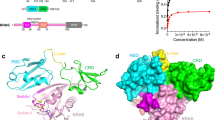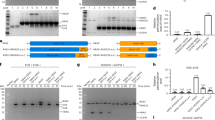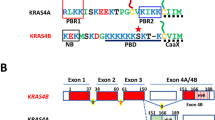Abstract
Different sites of plasma membrane attachment may underlie functional differences between isoforms of Ras. Here we show that palmitoylation and farnesylation targets H-ras to lipid rafts and caveolae, but that the interaction of H-ras with these membrane subdomains is dynamic. GTP-loading redistributes H-ras from rafts into bulk plasma membrane by a mechanism that requires the adjacent hypervariable region of H-ras. Release of H-ras-GTP from rafts is necessary for efficient activation of Raf. By contrast, K-ras is located outside rafts irrespective of bound nucleotide. Our studies identify a novel protein determinant that is required for H-ras function, and show that the GTP/GDP state of H-ras determines its lateral segregation on the plasma membrane.
This is a preview of subscription content, access via your institution
Access options
Subscribe to this journal
Receive 12 print issues and online access
$209.00 per year
only $17.42 per issue
Buy this article
- Purchase on Springer Link
- Instant access to full article PDF
Prices may be subject to local taxes which are calculated during checkout







Similar content being viewed by others
References
Johnson, L. et al. K-ras is an essential gene in the mouse with partial functional overlap with N-ras. Genes Dev. 11, 2468– 2481 (1997).
Umanoff, H., Edelmann, W., Pellicer, A. & Kucherlapati, R. The murine N-ras gene is not essential for growth and development. Proc. Natl Acad. Sci. USA 92, 1709– 1713 (1995).
Yan, J., Roy, S., Apolloni, A., Lane, A. & Hancock, J. F. Ras isoforms vary in their ability to activate Raf-1 and phosphoinositide 3-kinase. J. Biol. Chem. 273, 24052–24056 (1998).
Campbell, S. L., Khosravi-Far, R., Rossman, K. L., Clark, G. J. & Der, C. J. Increasing complexity of Ras signaling . Oncogene 17, 1395–1413 (1998).
Hancock, J. F., Magee, A. I., Childs, J. E. & Marshall, C. J. All ras proteins are polyisoprenylated but only some are palmitoylated. Cell 57, 1167–1177 ( 1989).
Hancock, J. F., Paterson, H. & Marshall, C. J. A polybasic domain or palmitoylation is required in addition to the CAAX motif to localize p21ras to the plasma membrane. Cell 63, 133–139 ( 1990).
Apolloni, A., Prior, I. A., Lindsay, M., Parton, R. G. & Hancock, J. F. H-ras but not K-ras traffics to the cell surface via the exocytic pathway. Mol. Cell. Biol. 20, 2475–2487 ( 2000).
Choy, E. et al. Endomembrane trafficking of Ras: the CAAX motif targets proteins to the ER and Golgi. Cell 98, 69– 80 (1999).
Roy, S. et al. Dominant-negative caveolin inhibits H-ras function by disrupting cholesterol-rich plasma membrane domains. Nature Cell Biol. 1, 98–105 (1999).
Hancock, J. F., Cadwallader, K., Paterson, H. & Marshall, C. J. A CAAX or a CAAL motif and a second signal are sufficient for plasma membrane targeting of ras proteins. EMBO J. 10, 4033 –4039 (1991).
Harder, T., Scheiffele, P., Verkade, P. & Simons, K. Lipid domain structure of the plasma membrane revealed by patching of membrane compartments. J. Cell Biol. 141, 929– 942 (1998).
Madore, N. et al. Functionally different GPI proteins are organized in different domains on the neuronal surface. EMBO J. 18, 6917–6926 (1999).
Song, S. K. et al. Co-purification and direct interaction of Ras with caveolin, an integral membrane protein of caveolae microdomains. Detergent-free purification of caveolae microdomains. J. Biol. Chem. 271, 9690–9697 (1996).
Koleske, A. J., Baltimore, D. & Lisanti, M. P. Reduction of caveolin and caveolae in oncogenically transformed cells. Proc. Natl Acad. Sci. USA 92, 1381–1385 (1995).
Willumsen, B. M. et al. Transforming p21 ras protein: flexibility in the major variable region linking the catalytic and membrane anchoring domains. EMBO J. 4, 2893–2896 ( 1985).
Khwaji, A., Rodriguez-Viciana, P., Wennstrom, S., Warne, P. H. & Downward, J. Matrix adhesion and Ras transformation both activate a phosphoinisotide 3-OH kinase and protein kinase B/Akt cellular survival pathway. EMBO J. 16, 2783– 2793 (1997).
Downward, J., Graves, J. D., Warne, P. H., Rayter, S. & Cantrell, D. A. Stimulation of p21ras upon T-cell activation. Nature 346, 719– 723 (1990).
Porfiri, E. & Hancock, J. F. Stimulation of nucleotide exchange on Ras- and Rho-related proteins by small GTP-binding protein GDP dissociation stimulator. Methods Enzymol. 256, 85– 90 (1995).
Morrison, D. K. & Cutler, R. E. The complexity of Raf-1 regulation. Curr. Opin. Cell Biol. 9, 174–179 (1997).
Roy, S., Lane, A., Yan, J., McPherson, R. & Hancock, J. F. Activity of plasma membrane recruited Raf-1 is regulated by Ras via the Raf zinc finger. J. Biol. Chem. 272, 20139–20145 (1997).
Roy, S. et al. 14-3-3 potentiates Ras dependent Raf-1 activation in vitro and in vivo. Mol. Cell. Biol. 18, 3947–3955 (1998).
Mason, C. et al. Serine and tyrosine phosphorylations cooperate in Raf-1, but not B-Raf activation. EMBO J. 18, 2137– 2148 (1999).
Leevers, S. J., Paterson, H. F. & Marshall, C. J. Requirement for Ras in Raf activation is overcome by targeting Raf to the plasma membrane. Nature 369 , 411–414 (1994).
Stokoe, D., Macdonald, S. G., Cadwallader, K., Symons, M. & Hancock, J. F. Activation of Raf as a result of recruitment to the plasma membrane. Science 264, 1463–1467 (1994).
Niv, H., Gutman, O., Henis, Y. I. & Kloog, Y. Membrane interactions of constitutively active GFP–Ki-Ras4B and their role in signaling. J. Biol. Chem. 274, 1606–1613 (1998).
Melkonian, K. A., Ostermeyer, A. G., Chen, J. Z., Roth, M. G. & Brown, D. A. Role of lipid modifications in targeting proteins to detergent-resistant membrane rafts. J. Biol. Chem. 274, 3910–3917 ( 1999).
Moffett, S., Brown, D. A. & Linder, M. E. Lipid-dependent targeting of G-proteins into rafts . J. Biol. Chem. 275, 2191– 2198 (2000).
Pralle, A., Keller, P., Florin, E. L., Simons, K. & Horber, J. K. H. Sphingolipid-cholesterol rafts diffuse as small entities in the plasma membrane of mammalian cells. J. Cell. Biol. 148, 997–1007 (2000).
Schutz, G. J., Kada, G., Pastushenko, V. P. & Schindler, H. Properties of lipid microdomains visualized by single molecule microscopy . EMBO J. 19, 892–901 (2000).
Mineo, C., Gill, G. N. & Anderson, R. W. Regulated migration of epidermal growth factor receptor from caveolae. J. Biol. Chem. 274, 30636 –30643 (1999).
Scheel, J., Srinivasan, J., Honnert, U., Henske, A. & Kurzchalia, T. V. Involvement of caveolin-1 in meiotic cell-cycle progression in Caenorhabditis elegans. Nature Cell Biol. 1, 127–129 (1999).
Hall, A. & Self, A. J. The effect of Mg2+ on the guanine nucleotide exchange rate of p21N-ras. J. Biol. Chem. 261, 10963–10965 ( 1986).
Beranger, F. et al. Determination of structural requirements for the interaction of Rab6 with RabGDI and Rab geranylgeranyltransferase. J. Biol. Chem. 269, 13637–13643 ( 1994).
Acknowledgements
We thank S. Kornfeld for helpful advice and M. Lindsay for technical assistance. This work was supported by grants from the National Health and Medical Research Council of Australia to R.G.P. and J.F.H. J.F.H. is also supported by the Royal Children's Hospital Foundation of Queensland. The Institute of Molecular Bioscience is a Special Research Centre of the Australian Research Council.
Author information
Authors and Affiliations
Corresponding author
Supplementary information
Rights and permissions
About this article
Cite this article
Prior, I., Harding, A., Yan, J. et al. GTP-dependent segregation of H-ras from lipid rafts is required for biological activity. Nat Cell Biol 3, 368–375 (2001). https://doi.org/10.1038/35070050
Received:
Revised:
Accepted:
Published:
Issue Date:
DOI: https://doi.org/10.1038/35070050
This article is cited by
-
Smoothened (SMO) regulates insulin-like growth factor 1 receptor (IGF1R) levels and protein kinase B (AKT) localization and signaling
Laboratory Investigation (2022)
-
TGFβ-induced changes in membrane curvature influence Ras oncoprotein membrane localization
Scientific Reports (2022)
-
Elastic deformations mediate interaction of the raft boundary with membrane inclusions leading to their effective lateral sorting
Scientific Reports (2020)
-
Avicin G is a potent sphingomyelinase inhibitor and blocks oncogenic K- and H-Ras signaling
Scientific Reports (2020)
-
Functional link between plasma membrane spatiotemporal dynamics, cancer biology, and dietary membrane-altering agents
Cancer and Metastasis Reviews (2018)



